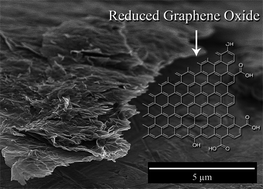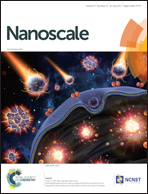Experimental review: chemical reduction of graphene oxide (GO) to reduced graphene oxide (rGO) by aqueous chemistry†
Abstract
The electrical conductivity of reduced graphene oxide (rGO) obtained from graphene oxide (GO) using sodium borohydride (NaBH4) as a reducing agent has been investigated as a function of time (2 min to 24 h) and temperature (20 °C to 80 °C). Using a 300 mM aqueous NaBH4 solution at 80 °C, reduction of GO occurred to a large extent during the first 10 min, which yielded a conductivity increase of 5 orders of magnitude to 10 S m−1. During the residual 1400 min of reaction, the reduction rate decreased significantly, eventually resulting in a rGO conductivity of 1500 S m−1. High resolution XPS measurements showed that C/O increased from 2.2 for the GO to 6.9 for the rGO at the longest reaction times, due to the elimination of oxygen. The steep increase in conductivity recorded during the first 8–12 min of reaction was mainly due to the reduction of C–O (e.g., hydroxyl and epoxy) groups, suggesting the preferential attack of the reducing agent on C–O rather than C![[double bond, length as m-dash]](https://www.rsc.org/images/entities/char_e001.gif) O groups. In addition, the specular variation of the percentage content of C–O bond functionalities with the sum of Csp2 and Csp3 indicated that the reduction of epoxy or hydroxyl groups had a greater impact on the restoration of the conductive nature of the graphite structure in rGO. These findings were reflected in the dramatic change in the structural stability of the rGO nanofoams produced by freeze-drying. The reduction protocol in this study allowed to achieve the highest conductivity values reported so far for the aqueous reduction of graphene oxide mediated by sodium borohydride. The 4-probe sheet resistivity approach used to measure the electrical conductivity is also, for the first time, presented in detail for filtrate sheet assemblies’ of stacked GO/rGO sheets.
O groups. In addition, the specular variation of the percentage content of C–O bond functionalities with the sum of Csp2 and Csp3 indicated that the reduction of epoxy or hydroxyl groups had a greater impact on the restoration of the conductive nature of the graphite structure in rGO. These findings were reflected in the dramatic change in the structural stability of the rGO nanofoams produced by freeze-drying. The reduction protocol in this study allowed to achieve the highest conductivity values reported so far for the aqueous reduction of graphene oxide mediated by sodium borohydride. The 4-probe sheet resistivity approach used to measure the electrical conductivity is also, for the first time, presented in detail for filtrate sheet assemblies’ of stacked GO/rGO sheets.



 Please wait while we load your content...
Please wait while we load your content...